Search results for "moomins/feed/www.booksfromfinland.fi/2014/10/letters-from-tove"
Réka Király: Yksi vielä [One more]
11 February 2015 | Mini reviews, Reviews
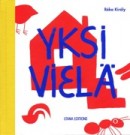 Yksi vielä
Yksi vielä
[One more]
Kuvitus [Ill. by]: Réka Király
Helsinki: Etana Editions 2014. 32 pp., ill.
ISBN 978-952-7105-01-6
€17.90, hardback
Réka Király, born in Hungary in 1977, has previously collaborated with fellow illustrator Marika Maijala. Her bright, harmonious fields of primary-colours are well suited to a story influenced by simple folk narratives that tells of animals coming one by one to stay in an uninhabited small cabin. As expected, the cabin creaks and cracks and finally breaks into a million pieces that fly into the air. Kiréaly’s simplified animal characters are very sympathetic. Yksi vielä is a good example of a picture book that develops a child’s sense of image and shape through clever visual inventiveness.
Translated by Lola Rogers
Iiro Küttner & Ville Tietäväinen: Puiden tarinoita: Puuseppä [Tales by trees: the carpenter]
26 February 2015 | Mini reviews, Reviews
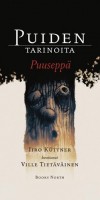 Puiden tarinoita: Puuseppä
Puiden tarinoita: Puuseppä
[Tales by trees: The carpenter]
Kuvitus [Ill. by] Ville Tietäväinen
Helsinki: Books North, 2014. 30 pp., ill.
ISBN 978-952-67980-5-9
€28.90, hardback
The picture book surprise of the year is Puuseppä, the first book in the Tales by trees trilogy, launched with fanfare by Books North, a new small press, and extremely polished in appearance. The story pays homage to the classic tales of Zacharias Topelius and H.C. Andersen. The carpenter of the story is under the special protection of the emperor, and has the time and money to make anything he wants. His chosen project is stupendous – to isolate himself for 30 years and build an enormous tree, using various types of wood and complicated construction techniques. He forgets his family and finally wears himself out in the process. The story closes with a sly moral reflective of Finnish contemporary society, about forced labour, the pressures of working life, and the value of work. Comics artist Ville Tietäväinen’s illustrations are tactile – the picture of tree rings makes you want to touch it and feel the rough texture of the cut wood. Books North is an offshoot of Agency North Oy, which specialises in promoting Finnish drama and film abroad.
Translated by Lola Rogers
Marjatta Levanto & Julia Vuori: Leonardo. Oikealta vasemmalle [Leonardo. From right to left]
6 March 2015 | Mini reviews, Reviews
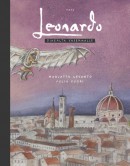 Leonardo. Oikealta vasemmalle
Leonardo. Oikealta vasemmalle
[Leonardo. From right to left]
Teksti [Text by]: Marjatta Levanto
Kuvitus [Ill. by]: Julia Vuori
Design: Dog Design
Helsinki: Teos, 2014. 113 pp., ill.
ISBN 978-951851-467-4
€34.90, hardback
This handsome non-fiction book is a lavishly illustrated biography of the 15th-century Italian artist genius Leonardo da Vinci. The title refers to the fact that he employed ‘mirror’ writing in his diaries and notebooks. Art historian Marjatta Levanto has published several works on art for children and young people, and many of them have been illustrated by Julia Vuori. Leonardo introduces to the reader the world of the Italian renaissance, the artist’s astonishing and unique inventions – such as various human flying devices – his philosophical writings, his anatomical studies and his magnificent paintings and drawings. Julia Vuori’s amusing little vignettes and larger, colourful illustrations comment on the narrative and mingle with the text and the reproductions of Leonardo’s artwork. Some pictures are printed on transparent pages. This beautiful book is a treasure trove to a reader of any age.
Marja-Leena Mikkola: Helmenkantaja [The pearl bearer]
19 February 2015 | Mini reviews, Reviews
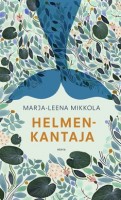 Helmenkantaja
Helmenkantaja
[The pearl bearer]
Helsinki: Otava, 2014.125 pp.
ISBN 978-951-1-28182-5
€23.90, hardback
Marja-Leena Mikkola (born 193x) has had a long career as a poet and translator. She has also written books for children and young adults, and Helmenkantaja shows her thorough familiarity with Anglo-Saxon fantasy fiction. Charles Kingsley’s Water Babies as well as H.C. Andersen’s little mermaid seem to glimmer in the background of this story. True to Mikkola’s ethos, the novel has a dose of ecocriticism in its theme of protection of a threatened pearl oyster. Reetta is fed up with looking out for her younger siblings at the family’s summer cabin; it feels as if the summer is slipping away. This everyday tale gradually breaks off into an exciting adventure in an underwater kingdom. The water boy, heir to the queen of the water, has to be rescued from the clutches of the water wizard. This difficult task requires a daredevil like Reetta, who, in additon to many other important qualities, has the gift of storytelling.
Translated by Lola Rogers
Timo Parvela: Paten aikakirjat [Pate’s chronicles]
26 February 2015 | Mini reviews, Reviews
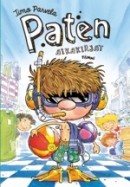 Paten aikakirjat
Paten aikakirjat
[Pate’s chronicles]
Kuvitus [Ill. by]: Pasi Pitkänen
Helsinki: Tammi, 2014. 96 pp., ill.
ISBN 978-951-31-7800-0
€25.90, hardback
Timo Parvela has achieved acclaim and won readers both in Finland and abroad – in Germany in particular. His Maukka ja Väykkä (Purdy and Barker) series of children’s novels will also soon be published in Great Britain. The Ella series for beginning readers now includes no less than 17 books, and now Pate, one of Ella’s supporting characters, has got his own series. The international counterpart of Paten aikakirjat – abundantly illustrated by Pasi Pitkänen – might be someone like Jeff Kinney, illustrator for Diaries of a Wimpy Kid. After living aborad for many years, Pate’s Uncle Pentti makes a bustling entrance into Pate’s life. Timo Parvela delights as usual with his trademark contrasts between children and slightly weird adults. In between comic mishaps are tons of easy-to-read dialogue, comics and lists of silly things.
Translated by Lola Rogers
Panu Rajala: Tulisoihtu pimeään. Olavi Paavolaisen elämä [A torch into the darkness. The life of Olavi Paavolainen]
13 November 2014 | Mini reviews, Reviews
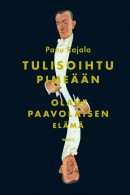 Tulisoihtu pimeään. Olavi Paavolaisen elämä
Tulisoihtu pimeään. Olavi Paavolaisen elämä
[A torch into the darkness. The life of Olavi Paavolainen]
Helsinki: WSOY, 2014. 624 pp., ill.
ISBN 978-951-040254-2
€32.90, hardback
In the 1920s Olavi Paavolainen (1903–1964) became the charismatic figurehead of the influential Tulenkantajat (‘Firebearers’) movement, which placed emphasis on internationalism and modernism. After the movement broke up Paavolainen worked as a prominent cultural leader and critic who knew how to provoke and to arouse admiration. The original travel book he wrote about Nazi Germany in peacetime is still read, as is his book Synkkä yksinpuhelu (‘A sombre monologue’, 1946), based on the diaries he kept during the Second World War. The criticism the book received (and doubts about its author’s ‘wisdom of hindsight’) contributed to Paavolainen’s silence as a writer. Although in the 1950s and 1960s as a director he brought about a flourishing of radio drama at the Finnish Broadcasting Company, he became an alcoholic. Much has been written about Paavolainen, but author and researcher Panu Rajala’s popular biography has managed to find new perspectives and gives a vivid portrayal of Paavolainen’s personality, the writers he knew, the colourful story of his complex relationships with women, and his travels. There is less analysis of his literary production, though the content and reception of his books are discussed.
Translated by David McDuff
Back to the sources
23 October 2014 | Essays, Non-fiction, On writing and not writing
In this series, authors discuss the difficulties of their trade. Jari Järvelä finds it difficult to stop gathering source material which then gets piled in towers on his desk and in sacks around it. He knows that it’s got to stop though – for when it does, the stories will finally emerge, and life is a bliss… for a moment
When I was younger I thought that writing a novel began with the moment when I sat down at my desk and pressed a key for the first time. A. Hmmm…no, H. No, let’s make that S. No no no, I need a more original beginning…Z!
That’s not the case. The writing of a novel begins between two and twenty years before the choice of the first letter and the first word. Sometimes longer.
In the case of my novel Särkyvää (‘Fragile’, 2014), I know the exact moment of its birth.
Before I began to make a career as an author, I spent a year as a teacher at Hamari school in Porvoo. It was the beginning of the 1990s. Hamari was an old sawmill community on the sea, full of wooden houses more than a century old and motor boats put-putting toward the horizon. The headmaster looked more like a sea dog than a teacher; one morning he announced that it was his fortieth birthday. After that he sat down on the staff-room sofa, fell into deep thought and suddenly ejaculated, ‘Why the hell does a person have to gather so much junk in their life?!’ More…
Herman Lindqvist: Kun Suomi oli Ruotsi [When Finland was Sweden]
18 December 2014 | Mini reviews, Reviews
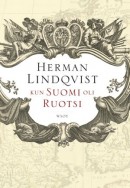 Kun Suomi oli Ruotsi
Kun Suomi oli Ruotsi
[When Finland was Sweden]
(original Swedish title: När Finland var Sverige, 2013)
Suom. [Translated from Swedish by] Heikki Eskelinen
Helsinki: WSOY, 2014. 497 pp., ill.
ISBN 978-951-0-40491-1
€44, hardback
The Swedish historian and journalist Herman Lindqvist is the author of dozens of popular non-fiction books. When Finland was Sweden is primarily intended for Swedish readers – an overview of the period when Finland was part of the Swedish kingdom – and it is partly based on new research. Finland became an integral part of the western neighbouring country in stages – including armed force – a process that was complete by the beginning of the fourteenth century. It remained an eastern borderland of the Kingdom of Sweden until the year 1809. The period was marked both by the rise of Sweden in the 16th century to become a great Baltic power and its decline in that role a hundred years later. Lindqvist connects up the different stages of Finland’s absorption into Sweden in a colourful and lively way. He shows how the influences went in both directions between the western and eastern part of the kingdom; the influence of the Finns could be seen both on the battlefields and in politics. The traces of the long time the two countries spent together are still visible today in both, thought in Finland they are stronger than in Sweden.
Translated by David McDuff
Wow-factor?
6 November 2014 | This 'n' that
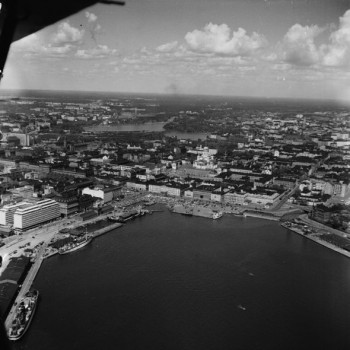
Helsinki harbour: aerial photo from the German Quick magazine, by Volker von Bonin, 1952. The proposed site for the Guggenheim building is bottom left. Photo: Helsinki City Museum
The winner of the Guggenheim Helsinki Design Competition, organised by the Solomon R. Guggenheim Foundation, will be announced in June 2015. ‘An innovative, multidisciplinary museum of art and design’, the winning building, if it will be realised, is likely to be a new ‘architectural dream’.
1,715 submissions were received from 77 countries; a shortlist of six finalists will be announced on 2 December.
In 2012 when the Guggenheim project (see our post from 2012) began to be discussed, the deep ranks of Helsinki taxpayers protested in public by saying that they did not want a costly new monument (building costs 130 million euros) in the city for which it would have been necessary to pay – in addition to maintenance costs – ca. 26 million euros to the American brand for the use of its name during the next 20 years. Finally the City Council voted 8-7 against the mayor’s motion to build the museum.
A comparison: the building costs of an urgently needed new children’s university hospital are 160 million euros: as the state was not able to fully finance the project in the near future, it was decided (in 2013) that 30 million euros would be raised by private sponsors and the general public in order to ensure the beginning of the construction work in 2014. (The goal was reached last August, but the fund-raising campaign will go on to decrease the loan capital, 50 million.) This project has been referred to by the opposers of the Guggenheim project in particular: if the state cannot provide the funds for a national children’s hospital, how could – and why should – it commit itself, albeit with smaller sums, to sponsoring an American art museum in Finland?
No money from the state was promised. No art-minded private sponsors of a future Guggenheim announced themselves in the public either. It turned out, however, that enough private sponsor money was available for an international architecture competition: in 2013 a tentative, central site for a future Guggenheim building was reserved for the competition project, for two years, in Helsinki harbour.
Since that, a group of independent arts organisations has issued a call for submissions for alternative ideas: ‘The next Helsinki’: a new competition aims at bringing forth projects that ‘attach artistry to all aspects of everyday urbanism’, and it is open to all, not just ‘starchitects’, ‘…because the solution is not simply an urban designer’s or artist’s task.’ Deadline is 2 March, 2015.
The organisations taking part are Checkpoint Helsinki, G.U.L.F. (Global Ultra Luxury Faction), Occupy Museums and Terreform, New York. ‘The next Helsinki’ states: ‘The Guggenheim Foundation has launched a design competition on one of Helsinki’s most valuable and compelling physical sites for a new Guggenheim building, in hopes of a transformation akin to the “miracle” in Spain [Bilbao]. The City of Helsinki is tempted to spend hundreds of millions of municipal euros in return for the benefits of the branding of the city with someone else’s mark. Is this really the best use for the site and tax money?’
It remains to be seen who will be the winners, and what will be won.
Cool, not ice-cool
17 October 2013 | This 'n' that
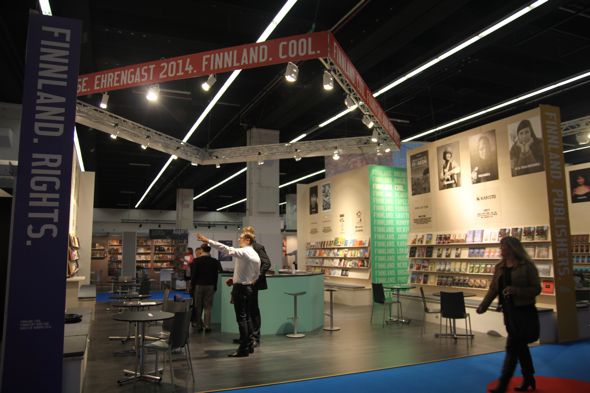
Getting ready: book fair scenery, 2013. Photo: FILI
The Finnish book world is preparing for the big event of ‘F14’: Finland will appear as Guest of Honour at the Frankfurt Book Fair in October next year.
The slogan for this enterprise is Finnland. Cool.
The coordinating organ is FILI, the Finnish Literature Exchange, a part of the Finnish Literature Society. Co-operating with FILI are three ministries, literary organisations and publishers, the Finnish Embassy and Finnland-Institut in Berlin and the Goethe-Institut in Helsinki.
Last week a large proportion of the FILI staff – who now need to keep their cool for the next busy year – went to Frankfurt, and on 10 October (aptly, the memorial day of the national author Aleksis Kivi and also Finnish Literature Day) the press conference was opened by the Finnish Minister of Culture and Sport, Paavo Arhinmäki. On 13 October the 2013 Guest of Honour, Brazil, passed the baton to Finland. (More photographs here.)
The world’s largest book fair, Frankfurt, attracts some 300,000 visitors each year. Accessible to both professionals and the general public, the fair is also the biggest cultural event in Germany.
The Guest of Honour countries receive a vast amount of attention in the media, and the number of new translations from the respective languages into German, as well as other languages, will increase.
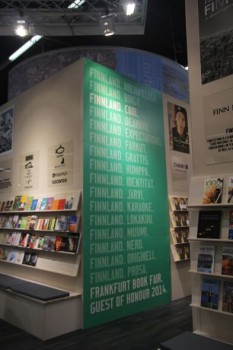
Finnland: arktik. Blondi. Cool. Demokratia. Einsam. Formula 1. Girji. Heimat. Ihminen. Joy…. Photo: FILI
The total Finnish budget for the years 2010–2015 is approximately four million euros, half of it money from the government. And the mission? Here are some warm words from the cool FILI agenda:
‘Why are Finns reading so much? Why are Finns so good at reading? Because we love it. Because reading plays such an important role in everyday life.
‘And because it is so important in Finland that everybody has access to reading – regardless of whether you are male or female, where you live, where you work, what your education or talent is. Fun, everyday life and for everyone – these are the main themes of the satellite programme for the Guest of Honour at the Frankfurt Book Fair 2014.’
Ville Laamanen: Suuri levottomuus. Olavi Paavolaisen kultturinen katse ja matkat 1936-39 [A great restlessness. Olavi Paavolainen’s cultural gaze and travels 1936-1939].
2 April 2015 | Mini reviews, Reviews
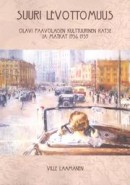 Ville Laamanen
Ville Laamanen
Suuri levottomuus. Olavi Paavolaisen kultturinen katse ja matkat 1936-39 [A great restlessness. Olavi Paavolainen’s cultural gaze and travels 1936-1939].
Turku: K&H, 2014. 346p., ill.
ISBN 978-951-29-5632-6
€32, paperback
The writer Olavi Paavolainen (1903-1964) was an important cultural critic in Finland in the years between the two World Wars. The historian Ville Laamanen’s doctoral thesis Suuri levottomuus explores how Paavolainen interpreted the encounter between the modern and totalitarianism. Laamanen examines Paavolainen’s journeys to National Socialist Germany and South America, where he was able to gain distance from Eurocentricity. Paavolainen published three books on the basis of these journeys, and these form the central sources for Laamanen’s research. The outbreak of the Winter War in Finland in 1939 prevented the publication of a fourth volume. This work would have focused on the Soviet Union, which at that point was little-known. The most important offerings of Laamanen’s book are the research results based on material from Russian archives which has hitherto remained unexamined. Paavolainen was not a communist, but was accorded VIP status in the Soviet Union and was able to gain a diverse view of the country. Laamanen also places Paavolainen in the broader cultural context of the 1930s. The book is at the same time a rigorous academic study and a well-written, gripping portrait of a still interesting Finnish intellectual during an important period.
Reading matters? On new books for young readers
9 January 2014 | Articles, Children's books, Non-fiction
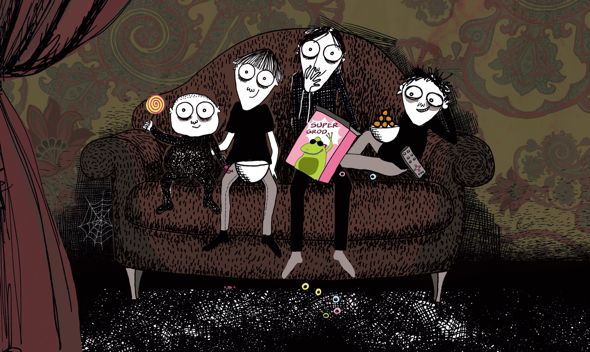
The Pixon brothers don’t read books, they love the telly: story by Malin Kivelä, illustrations by Linda Bondestam (Bröderna Pixon och TV:ns hemtrevliga sken, ‘The Pixon brothers and the homely shimmer of the telly’)
Finnish picture books for children have long been reliable export goods around the world. In the last few years, a number of novels for children have come along in their wake: works by authors such as Timo Parvela and Siri Kolu have been translated into a good many languages.
Now young adult literature has also blazed a trail on to the international market – in what also seems to be almost a matter of precision timing with regard to the Frankfurt Book Fair 2014. Finnish publishers have been investing in their home-grown lists of children’s and young adult books ever since the turn of the millennium, and now the time has come to harvest the fruits of their long-term efforts.
Ove Enqvist & Heikki Tiilikainen: Linnakesaaret. Rannikkolinnakkeiden elämää sodassa ja rauhassa [The fortress islands. The life of the coastal bastions in war and peace]
2 October 2014 | Mini reviews, Reviews
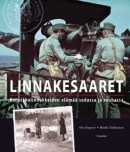 Linnakesaaret. Rannikkolinnakkeiden elämää sodassa ja rauhassa
Linnakesaaret. Rannikkolinnakkeiden elämää sodassa ja rauhassa
[Fortress islands. The life of coastal bastions in war and peace]
Helsinki: Tammi, 2014. 301 pp., ill.
ISBN 978-951-31-8005-8
€53.90, hardback
Finland’s coastal artillery was created after independence in 1918 to protect the country’s long coastline. Part of the system was, however, built in the early 20th century during the period of Russian rule for artillery batteries that were formed to provide security for St Petersburg. This carefully constructed and handsomely illustrated ‘coffee table book’, by two former bastion officers and non-fiction authors, charts the history of the coastal artillery until the decommissioning of the service: in 1998 its functions were transferred to other branches of the military. The main emphasis is on the early history, and nearly half of the book is devoted to a portrayal of the Second World War period. During the Winter and Continuation Wars the coastal artillery played a major role in Finland’s defence. Fierce artillery battles took place on the fortress islands, and there was also hand-to-hand fighting on them. The book presents a comprehensive account the development and operation of the bastions and the artillery in both wartime and peacetime. Light is shed on the diverse aspects of the working lives and recreations of soldiers and civilians in the harsh and demanding conditions of the outer islands.
Translated by David McDuff
Finland goes German
17 July 2009 | In the news
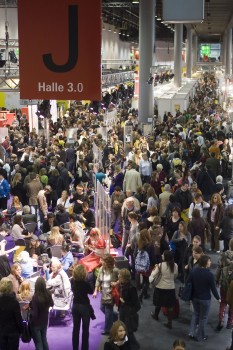
World of books: hustle and bustle at the Frankfurt Book Fair, 2008 - Photo: Fernando Baptista
Competition is hard in the book world, both nationally and internationally, so it’s big news that five years from now Finland will be the theme country at Frankfurt Book Fair, the world’s biggest encounter of those who work in the book publishing business.

